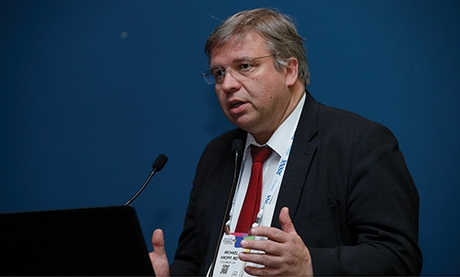New generation photon counting PET detector technology may be a game-changer for PET imaging, delivering reliable, ultra-fast whole body PET/CT within minutes.

Knopp
In a Tuesday session, Michael Knopp, MD, PhD, professor of radiology and Novartis Chair of Imaging Research at The Ohio State University's Wexner Medical Center, presented the promising results of a phase II clinical trial assessing the feasibility of the technology.
He and his team developed the intra-individual study comparing a new generation, digital PET/CT system (dPET) with a current generation, conventional system (cPET). They performed three separate acquisitions on 63 prospective patients scheduled for FDG whole-body PET/CT.
Investigational dPET was imaged approximately 55 minutes after an injection of 13mCi FDG at 90 seconds per bed position and approximately 17 minutes of table time. Then, a true, ultra-fast acquisition was made with a two-minute scan at nine seconds per bed position.
Standard cPET imaging was performed approximately 80 minutes post-injection with 90 seconds per bed position acquired during an average table time of about 20 minutes.
The resulting data sets were evaluated by three blinded reviewers who examined the visual appearance of noise in the whole-body scans, noise of liver in the axial plane, diagnostic readability assessed by reader and a match comparison of the nine-second dPET against the 90-second cPET.
"At first, the nine-second acquisitions looked horrible, but that wasn't the whole truth," Dr. Knopp said. "Through optimized reconstruction methodology, we were able to get very acceptable image quality. All ultrafast scans were classified to be assessable."
Visual assessment scores were significantly higher for the 90 seconds/bed dPET whole-body scans compared to the nine-second scans. With optimization, no significant difference between the ultra-fast whole-body and cPET scans was reported.
The ultra-fast scans presented with slightly increased background noise levels and substantially fewer motion artifacts including bowel movements.
For Dr. Knopp, the results were somewhat unexpected. "We are imaging at 1/10th of the count density/time. I thought the ultra-fast imaging would show a larger number of unacceptable studies. I also did not anticipate that shorter imaging would lead to substantially less motion within the field of view," he said.
According to Dr. Knopp, though the concept of rapid acquisition is feasible, it requires count-density, adaptive, regularized reconstruction.
"While image reconstruction via iterative calculations is complex, we cannot keep the settings at the same defaults," he said. "Adjusting or regularizing the reconstruction was a key strategy that enabled this radical increase in speed."
The study predominantly consisted of head/neck, colorectal and lung cancer because, as Dr. Knopp noted, those were the available cases. However, when asked about pediatric applications, he said with the ability to perform low-dose, ultra-fast PET, sedation may also be reduced and multiple scanning sweeps could be performed quickly to allow radiologists to choose the image with the least motion.
"The magic is going to be happening in the reconstruction, so the more we are able to utilize the promising, advanced methodologies we have with deep learning and adaptive intelligence, at the end of the day, optimization will be possible between dose, reconstruction matrix and acquisition time."
With the ultra-fast technology, new PET workflow processes, improved patient comfort, minimized patient movement and whole-body, pseudo-dynamic imaging of FDG tracer are achievable.

